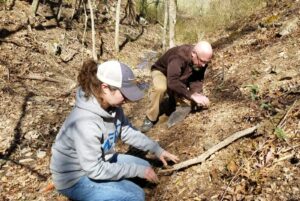Underneath Appalachia’s extensive forest canopy are soil beds that are rich in nutrients, blessed by water, and covered in numerous woodland plants and fungi. This mountainous and heavily forested region is one of the most biodiverse places on Earth and home to numerous marketable medicinal plants and fungi.
Two new grants from the U.S. Department of Agriculture aim to benefit the Appalachian Beginning Forest Farmer Coalition by streamlining the cultivation and harvesting of such crops so more landowners, farmers, and wild harvesters can add value to their enterprise.
According to Associate Professor John Munsell of Virginia Tech’s College of Natural Resources and Environment, who leads the coalition, there are scores of edible, medicinal, and decorative species with longstanding markets, such as goldenseal, black cohosh, American ginseng, ramps, galax, and bloodroot, and the bark, leaves, branches, and sap of trees like slippery elm, hard maple, and black walnut.
Virtually all of these forest products have long been harvested in the wild and traded through informal networks; however, the industries, cottage businesses, and consumers that depend on them increasingly seek reliably sourced raw materials.
Enter forest farming: an agroforestry practice where selections of plants, fungi, and specific tree species are intentionally grown under a well-managed tree canopy. Techniques range from fixed plantings in raised beds to wild populations that are intentionally stewarded to sustain production, all of which can result in higher price points because forest farming operations supply traceable, predictable, and sustainable raw materials.

The Appalachian Beginning Forest Farmer Coalition formed in 2016 with a $656,000 grant from the USDA National Institute of Food and Agriculture (NIFA) to increase awareness about forest farming, improve producer capacity, and strengthen market connections for forest farmers in Appalachia and beyond. NIFA recently awarded the coalition $593,000 in renewal funding to build on this work, and the USDA National Agroforestry Center followed up with a separate grant to take the coalition’s efforts national.
“We have over 1,000 members in our coalition, including forest farmers, federal and state agencies, nongovernment organizations, researchers, and educators,” said Munsell, who is the principal investigator on the supporting grants. “These new grants will help the coalition expand the practice of forest farming in Appalachia and ultimately nationwide, while also developing a self-sustaining association that supports forest farmers and other critical stakeholders, such as nonprofits, natural resources agencies, academics, and forest-dependent industries.”
While American ginseng may be what many think of first in relation to forest farming, Munsell stresses that there are historical markets for other species.
“I start many conversations by saying this is not just about ginseng,” said Munsell, a Virginia Cooperative Extension specialist and faculty member in the Department of Forest Resources and Environmental Conservation. “Ginseng is an iconic Appalachian medicinal plant with a unique and lucrative supply chain, but there are numerous other species native to the region that have long-standing markets. Price points for other species generally are drastically lower than ginseng; however, many are sold at much greater rates.”
Munsell hopes that American forest farmers can develop a strong reputation in the global market. “The businesses that depend upon these products have grown into a multibillion-dollar global industry, and what we see now is that some companies are willing to pay more for raw materials that have a known point of origin, assurances of stewardship, and an identifiable person, community, and forest behind it all.”
While supporting a producer base that can participate in the world market is an important ambition, the coalition also seeks to broaden agroforestry possibilities in Appalachia through an extensive education, outreach, and market connections program, which provides training and mentorship for farmers new to the field.
The coalition is also working to increase available planting stocks and to advance verified forest-grown programs with several partners so that farmers can more easily establish operations and cultivate crops.
“A critical part of our message is that many Appalachian communities have long supplied these forest products, but livelihoods, communities, and ecosystems have not benefited from meaningful investments in economic development,” Munsell said. “We see our coalition as a green strategy that stewards the natural resources in Appalachia while taking advantage of an evolving marketplace.”
The coalition recently received the 2020 Herbal Insight Award from the American Herbal Products Association, the country’s leading nutraceutical industry association with an important global supply chain footprint. The coalition was recognized for its central role in improving investments in the forests, people, and communities of Appalachia and beyond.
“The coalition is incredibly honored to receive the association’s Herbal Insight Award,” Munsell said. “This recognition reflects all that so many have done together for years to move forest farming to the forefront.”
- David Fleming

